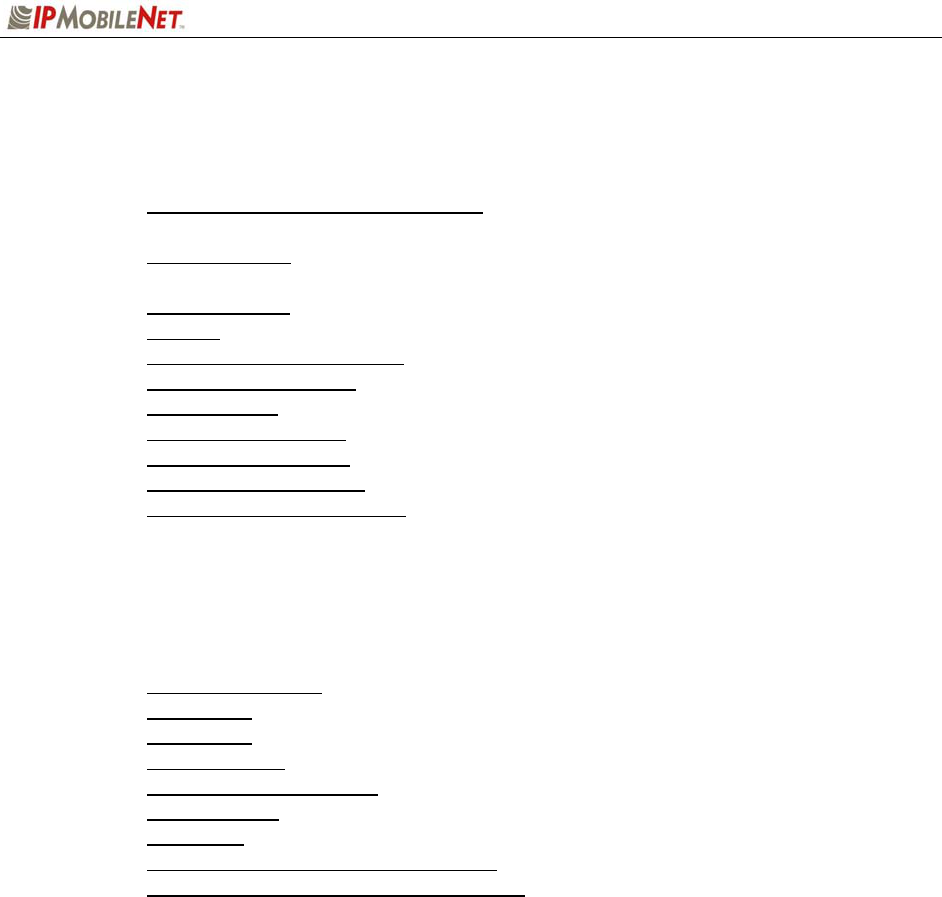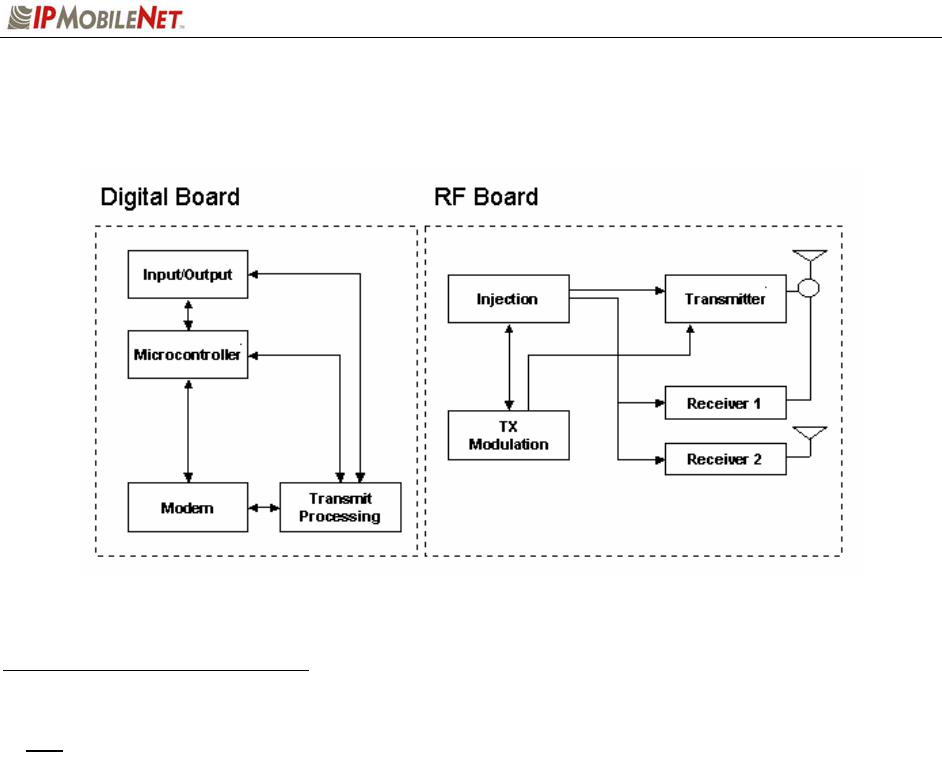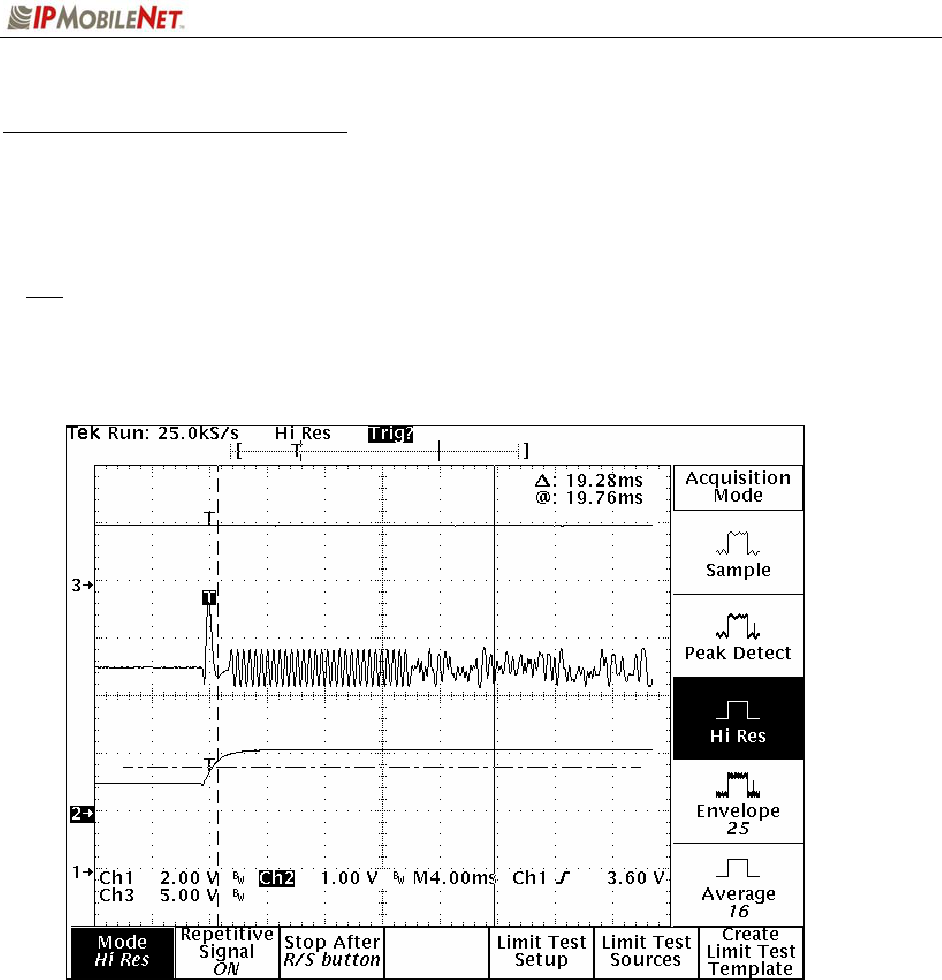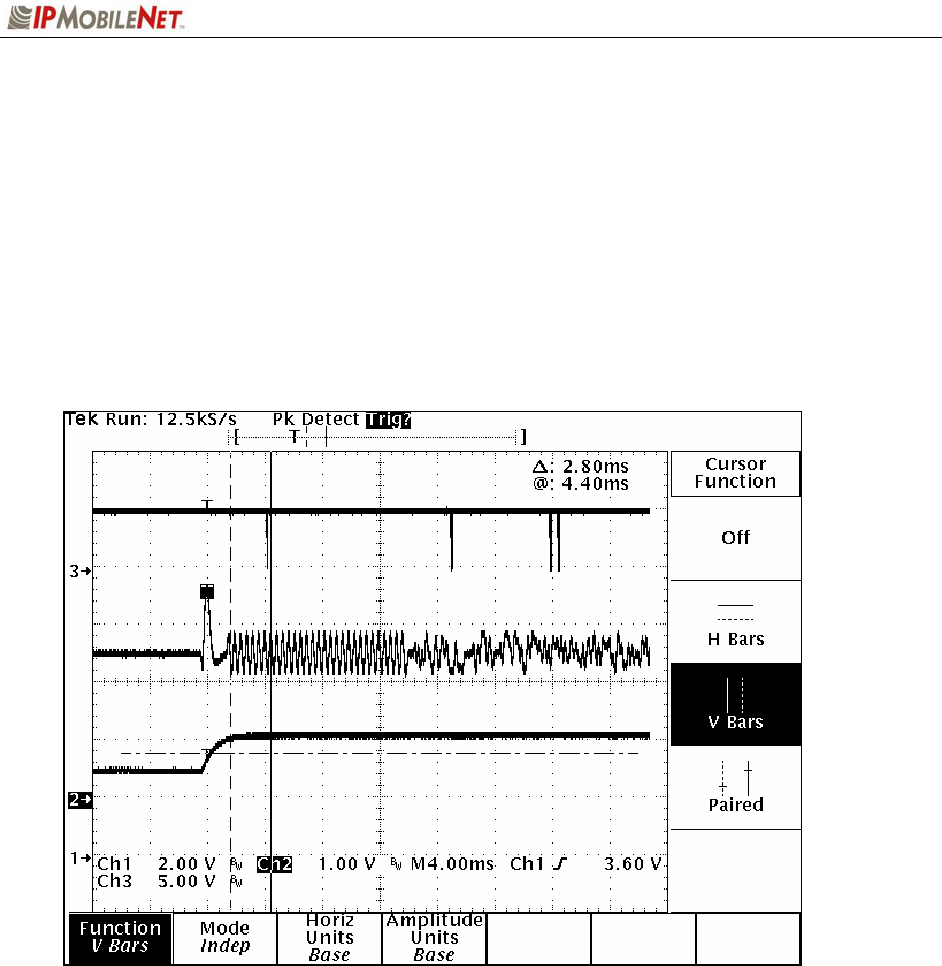IP Mobilenet IPM4748 IPM4 Mobile Radio User Manual 332652
IP Mobilenet, LLC IPM4 Mobile Radio 332652
Contents
- 1. User Manual
- 2. Installation manual
User Manual

I
IP
PS
Se
er
ri
ie
es
s
I
IP
PM
M4
4
M
Mo
ob
bi
il
le
e
R
Ra
ad
di
io
o
P
Pr
ro
od
du
uc
ct
t
O
Ow
wn
ne
er
r’
’s
s
M
Ma
an
nu
ua
al
l
Date Released: May 14, 2003
Document #: 516-80500-POM
Revision: A
Copyright 2003 IPMobileNet, Inc.
16842 Von Karman Avenue, Suite 200 Irvine, CA 92606
Voice: (949) 417-4590 Fax: (949) 417-4591
IPM4748-FCCRpt.doc Page ii
The term “IC”: before the radio certification number only signifies that Industry of Canada
technical specifications were met.
Operation is subject to the following two (2) conditions: (1) this devise may not cause
interference, and (2) this device must accept any interference, including interference that may
cause undesired operation of this device.
The following U.S. Patents apply to this product:
U.S. Patent numbers 5,640,695,6,018,647,6,243,393
Information contained in this document is subject to change without notice.
All rights reserved. Reproductions, adaptations, or translation without prior written permission is
prohibited, except as allowed under copyright laws.

TABLE OF CONTENTS
IPM4748-FCCRpt.doc Page 2
SECTION 1: THEORY OF OPERATION ................................................................................. 3
General Block Diagram................................................................................................ 3
General Block Diagram Definitions..................................................................... 3
IPM4 Mobile Radio Section Descriptions................................................................... 5
Microcontroller.................................................................................................... 5
Support Circuitry ................................................................................... 5
Inputs/Outputs .................................................................................................... 5
Modem .............................................................................................................. 6
VLogic and Digital Ground ................................................................................. 6
Receiver 1 Front-End ......................................................................................... 7
Receiver 1 IF ...................................................................................................... 7
Transmit Modulation........................................................................................... 7
Injection Synthesizer .......................................................................................... 8
Transmitter/TR Switch........................................................................................ 8
Power and Analog Ground ................................................................................. 8
SECTION 2: FACTORY TEST PROCEDURE ......................................................................... 9
Equipment List ............................................................................................................. 9
Programming and Configuring Mobile Radio.......................................................... 10
Adjustment / Alignment Procedures ........................................................................ 11
Receiver Injection............................................................................................. 11
Receiver 1
........................................................................................................ 11
Receiver 2
........................................................................................................ 12
Transmit Data................................................................................................... 13
Transmit Power Control.................................................................................... 14
Receive Data.................................................................................................... 15
Final Test.......................................................................................................... 16
Uplink Hardware Timing Verification ................................................................ 16
Downlink Hardware Timing Verification............................................................ 18
SECTION 3: SCHEMATIC DIAGRAMS AND PARTS LISTS................................................ 20
Schematic and Parts List Listing.............................................................................. 20
IPM4 Data Transceiver FCC Label Placement ......................................................... 21
IPM4 Data Transceiver FCC Label ............................................................................ 21
APPENDIX A: IPM4 CIRCUIT BOARD DIAGRAMS ............................................................. 49
APPENDIX B: IPM4 TEST DATA SHEET ............................................................................. 50

SECTION 1: THEORY OF OEPRATION
IPM4748-FCCRpt.doc Page 3
General Block Diagram
General Block Diagram Definitions
For increased data security, the modem supports the Federal Government developed Digital
Encryption Standard (DES) data encryption and decryption protocols. This capability requires
installation of third party, Internet Protocol (IP) compliant DES encryption and decryption
software on the system.
The IPM4 mobile radio is comprised of two (2) circuit boards, the digital board and the RF board. The
digital circuit board contains the following sections:
Input/Output Circuitry associated with the radio’s DB9 data connector providing all the
RS232 data and handshake functions, including the necessary level
changes.
Microcontroller Manages the operation of the radio, the modem, and determines which
receiver provides a better signal from a given transmission. Also provides
transmit time-out protection in the event a fault causes the radio to halt in
the transmit mode.
Modem Converts serial data into an analog audio waveform for transmission and
analog audio from the receiver to serial data. Within a single chip it
provides forward error detection and correction, bit interleaving for more
robust data communications, and third generation collision detection and
correction capabilities.
Power Supply The power supply creates the various voltages required by the digital
portion of the mobile radio.

SECTION 1: THEORY OF OPERATION
IPM4748-FCCRpt.doc Page 4
The RF circuit board contains the following sections:
Transmit Processing Circuitry that amplifies the analog audio signal from the modem and uses it
to modulate the voltage controlled oscillator (VCO) and 10 MHz reference
oscillator in the injection synthesizer section. Modulating the VCO and
reference oscillator simultaneously results in a higher quality FM signal.
Injection Synthesizer Provides programmable, ultra stable signals for the radio. Synthesizer
incorporates phase lock loop technology used for both receiving and
transmitting.
Injection In the receive mode, the synthesizer provides a local oscillator signal of 45
MHz above or below the selected receive channel frequency.
Transmitter Consists of an exciter and power amplifier module. The transmitter covers
the various frequency bands in segments. A different power amplifier
module is required for each segment. The transmitter circuitry includes a
T/R switch switching the antenna between transmitter and receiver 1
(TX/RX1).
Receiver 1/Receiver 2 Required to support the mobile DRS; two (2) discrete receivers are tuned
to the same channel and use two (2) antennas.
The receivers are double-conversion superheterodyne with a first
Intermediate Frequency (IF) of 45 MHz and a second IF frequency of 455
KHz. Each receiver consists of bandpass filters, an RF amplifier, a MMIC
mixer, crystal filters, and a one-chip IF system. The injection synthesizer
provides the first local oscillator signal. Outputs from each receiver include
RSSI and analog audio for the baseband routing circuitry and modem.
Power Supply Consists of circuitry that derives the various operating voltages for the RF
portion of the mobile radio.

SECTION 1: THEORY OF OPERATION
IPM4748-FCCRpt.doc Page 5
IPM4 Mobile Radio Section Descriptions
The IPM4 Mobile Radio works within a frequency range of 470 to 480 MHz and requires a 1/4-wavelength
antenna.
This section provides detailed descriptions of each of the sections within the IPM4 Mobile Radio. Refer to
Appendix A to view the IPM4 Mobile Radio Circuit Board Diagram.
Microcontroller (refer to schematic on page 26 & 27)
The microcontroller (U30) is a major component of the radio as it manages the operation of the radio. It
also controls the operation of the modem, and determines which receiver provides a better signal from a
given transmission. It provides transmit time-out protection in the event a fault causes the radio to halt in
the transmit mode. It utilizes a reduced instruction set computer (RISC) architecture which provides low
power operation and a powerful instruction set. Other features include a watchdog timer, serial universal
asynchronous receiver/transmitter (UART), two 8-bit timers, and 2 KB of electrically erasable
programmable read only memory (EEPROM) storage.
NOTE: The EEPROM Random Access Memory (RAM) stores the setup data entered by the
technician even if there is a loss of power.
Support circuitry
The support circuitry consists of the following:
A Supervisor Control Chip (U25) provides power-on reset.
The clock controls microcontroller operation and is generated by crystal Y3 and a Pierce oscillator
circuit (inside the U30-microcontroller).
The latch (U28) decodes low order address bits (A0-A7) from the address/data bits (AD0-AD7). It is
controlled by Address Latch Enable (ALE) output of U30 and the bits are used by the modem.
A 512Kx8 Static RAM Chip (U31) provides temporary storage of the radio’s configuration data
facilitating the technician with access to make changes.
Control logic is also an important part in the microcontroller section. The RAM chip select (RAMCS*)
and modem chip select (MODEMCS*) command lines are created by U26A, U27BCD, and U44ABC.
These gates decode four (4) high order address bits (A11-A15). The RAM is addressed by five (5)
memory addresses (MA14-MA18) bits decoded by U26D, U27A, and U24. This logic decodes port
address bits (PA14-PA18) to produce memory address bits (MA14-MA18) for the RAM chip.
Input/Output (refer to schematic on page 28)
Input/output components convert serial and handshake data from the modem section to RS232 levels,
and vice-versa. Chip U22 is an RS232 transmitter and receiver. It converts data in 5-volt logic form to
data in +/-12-volt form, as required by the RS232 standard. A charge pump power supply on the chip
converts the +5-volt DC logic power on pin 26 to the +12-volt and –12-volt levels required. Capacitors
C106-C109 generate these voltages by a charge pump. These values determine the operating voltages.

SECTION 1: THEORY OF OPERATION
IPM4748-FCCRpt.doc Page 6
Modem (refer to schematic on page 30)
The single-chip modem circuit converts parallel data to an analog audio waveform for transmission and
analog audio from a receiver to parallel data. In addition to the modem functions, the chip provides
forward error detection and correction (FEC), bit interleaving and Viterbi Soft Decision Algorithms for
more robust data communications.
The microcontroller section controls the modem operation. Address bus, address/data bus, and control
lines operate the modem chip. The modem circuitry is also run by a crystal-controlled clock, which
consists of crystal Y1 and an internal Pierce oscillator.
The received audio signal is demodulated into digital data appearing on the AD0-AD07 lines when the
MODEMCS* and RD* lines are low. The data goes to the microcontroller section for futher processing,
and then to the input/output section for conversion to RS232 or Ethernet signal levels.
During a transmission, outgoing data appearing on the AD0-AD07 lines is converted into a 4-level FSK
analog signal by the modem chip. This operation takes place when the MODEMCS* and WR* lines are
low. Data from the user’s MDC or VIU passes through the input/output section and microcontroller
section to the AD0-AD07 bus. After processing, data passes through a root raised cosine filter and is
output to TXMOD.
This modem supports 115.2 KBPS (serial port) and 19.2 KBPS (over-the-air) data transmission rates.
VLogic and Digital Ground (refer to schematic on page 31)
The VLogic and Digital Ground section consists of a pulse-width modulation (PWM) step-down DC-DC
converter (U20) that provides an adjustable output. It also reduces noise in sensitive communications
applications and minimizes drop out voltage.
An external Schottky diode (D2) is required as an output rectifier to pass inductor current during the
second half of each cycle to prevent the slow internal diode of the N-channel MOSFET from turning on.
This diode operates in pulse-frequency modulation (PFM) mode and during transition periods while the
synchronous rectifier is off.

SECTION 1: THEORY OF OPERATION
IPM4748-FCCRpt.doc Page 7
Receiver 1 Front-End (refer to schematic on page 41)
This section contains components that include several RF Bandpass filters, a low-noise amplifier, and a
MMIC mixer.
Incoming signals pass through one (1) pre-selector filter (FLT7) that selectively provides a high degree of
out-of-band signal rejection. A low-noise amplifier (U3) amplifies the selected signals and is followed by
an image and noise reject filter (FLT8). The output from FLT8 passes through a mixer (U4). U4 is a
MMIC mixer which mixes the receive injection (RXINJ1) signal from the synthesizer and the RF signal
from the antenna to produce a 45 MHz IF signal. This 45 MHz signal passes through crystal filters (FLT3
and FLT4) to the Receiver 1 IF section to provide the bulk of the Receiver’s selectivity.
Receiver 2 Front-End operates identical to Receiver 1 Front-End.
Receiver 1 IF (refer to schematic on page 42)
The major contributor of the IF subsystem (U33) a complete 45 MHz superheterodyne receiver chip
incorporating a mixer/oscillator, two limiting intermediate frequency amplifiers, quadrature detector,
logarithmic received signal strength indicator (RSSI), voltage regulator and audio and RSSI op amps.
Incoming 45 MHz signals appearing at RX1_45MHz pass through the low-voltage high performance
monolithic FM IF system. Within U33, the signals pass through a simple LC filter and are boosted by the
RF amplifier. The output of the RF amplifier drives a mixer. A crystal oscillator is controlled by crystal Y4
and provides the injection frequency for the mixer. The mixer output passes through a 455 KHz ceramic
filter (FL6). It is then amplified and passed through another ceramic filter (FL5) to a second gain stage.
The IF output drives a quadrature detector. The phase shift elements for the detector are C123 and
FLT5. The RSSI detector converts the AGC voltage generated inside the chip into a DC level
corresponding logarithmically to the signal strength. The Diversity Reception Controller uses BRSSI1 to
select the receiver with the best quality signal.
The audio is amplified by an op amp (U19C) and delivered to the power and analog ground circuitry via
the RXMOD1 output. High frequency de-emphasis is provided by a filter consisting of a resistor and a
capacitor. In order to match the audio signal levels with the other circuitry, a gain control is included. A
pot (R81) is necessary to adjust gain.
Receiver 2 IF operates identical to Receiver 1 IF.
Transmit Modulation (refer to schematic on page 45)
The analog circuitry in this section modulates the Transmitter. The data-bearing audio signal from the
modem appears at TXMOD. The audio is amplified by op amp (U70D). The output of U70D drives two
(2) amplifiers (U70B and U70C).
The transmitter uses dual-point modulation meaning the modulation is applied both to the VCO as well as
the reference oscillator (VCTCXO).
The upper amplifier (U70B) has adjustable gain. The output drives op amp (U70A), which inverts the
phase of the signal. Upon the start of a transmission, the modulating signal passes through to the
VCTCXO reference oscillator in the synthesizer. Some makes of VCTCXO oscillators do not require the
modulation signal to be inverted and a jumper block (JMP4) is provided to accommodate the oscillators.

SECTION 1: THEORY OF OPERATION
IPM4748-FCCRpt.doc Page 8
The lower op amp (U70C) amplifies the signal from the low pass filter and applies it to the VCO via the
VCOMOD output. Pot RV1 and RV2 are used to adjust maximum deviation.
Injection Synthesizer (refer to schematic on page 46)
The dual synthesizer chip (U38) is the major contributor of the injection synthesizer. This device contains
the key components of a phase locked loop (PLL), including a prescaler, programmable divider, and
phase detector. The selected frequencies are loaded into U38 as a clocked serial bit stream via the
PLL_DATA, PLL_CLOCK and PLL_ENABLE signals.
Frequency stability is determined by a temperature-compensated crystal oscillator module (VCTCXO)
(Y5) at a frequency stability of 1 PPM from –30C to +60C. This device has an input (REFMOD) that
accepts transmit modulation and voltage from a RX FREQ ADJUST pot. The pot allows the receiver to
be fine-tuned to the exact operating frequency.
Two (2) voltage control oscillators (VCO) are formed by integrated low-noise oscillators with buffered
outputs (U39 and U40) and associated circuitry. The VCO’s generate receiver and transmit injection
signals. The receiver control voltage is generated by the phase detector output (PDOUT) of U38 driving a
loop filter consisting of R111, R112, C185, C186, C42, R133, and C213. It integrates the pulses that
normally appear on PDOUT into a smooth DC control signal for U40. The output of U40 is split by U63
leading to outputs RXINJ1 and RXINJ2. A second output of U40 is returned to the synthesizer FIN input
via RXFB. This completes the loop signal path.
The transmitter control voltage is generated by the phase detector output (PDOUT-L) of U38 driving a
loop filter consisting of transmitter R135, R118, C195, C196, and C214. It integrates the pulses that
normally appear on PDOUT-L into a smooth DC control signal for U39. Upon transmit, the analog signal
from the modem and transmit processing circuitry is applied to the U39 tuning circuit at CR6. The output
of U39 is the TXINJ* signal. A second output of U39 returns to the synthesizer F-IN input via TXFB.
Transmitter/TR Switch (refer to schematic on page 47)
The transmitter section consists of a driver amplifier (U36) and a final power amplifier (U35). To transmit,
5-volt power is applied to the KEYPWR line. PA12V line is also powered up. This causes power
amplifier (U35) to boost the RF power to the desired level. Up to 40 watts are available from the
transmitter. Harmonic suppression is provided by C233, L43, and L44.
Power and Analog Ground (refer to schematic on page 48)
These sections consist of the power supplies and transmit control circuitry. Power from the vehicle’s
battery appears at VBATT. Diode D1 protects the voltage regulators by clamping any transient spikes on
the supply line. Such spikes typically occur while the engine is started. The supply line powers a series
of voltage regulators and the transmitter control circuitry, as follows:
Voltage regulator U46 provides 8-volt power for most other sections in the radio.
Voltage regulator U21 powers the transmit driver and T/R switch diodes as controlled by the
microcontroller.
Voltage regulator VR2 provides a low noise 3.3-volt source for the radio electronics.
In the transmit control circuitry, to transmit, the microcontroller makes TXKEYOUT* high. Forcing the P-
channel device to conduct, applying 12-volts via PA12V to the transmitter power amplifier bias pins.

SECTION 2: FACTORY TEST PROCEDURE
IPM4748-FCCRpt.doc Page 9
Equipment List
The following table lists the equipment required to perform the IPM4 Mobile Radio Factory Test
Procedure:
QTY DESCRIPTION MANUFACTURER MODEL
2
PC’s
One for Mobile
One for Base
Windows 9X w/
IPMessage
AVR
1 Service Monitor – Communication Test
Set HP HP8920B or
equivalent
1 Digital multi-meter Tektronix
Fluke
77 or
equivalent
1 DC power supply w/ ammeter, 13.8V,
23 Amps or more Astron RM35A
1 4-Channel Scope Tektronix TDS 460A
1 IPM4 Mobile Radio
1 IPM4 Calibrated Base Station
1 Internet Protocol Network Controller
(IPNC)
1 100 watt dummy load/attenuator Pasternack PE7021-40 or
equivalent
2 UHF Antennas (generic mag mount)
1 Serial cable DB9M-DB9F connectors IPMN p/n:
156-0245-020
1 IP power cable IPMN p/n:
502-82017-52
1 3-foot RF jumper cable with type N
connectors (generic)
1 Scope test probe (generic, X1
attenuation)
1 Ceramic tuning tool IPMN p/n:
44010006
1 ea #0, #1, and #2 Phillips screwdrivers
(generic)

SECTION 2: FACTORY TEST PROCEDURE
IPM4748-FCCRpt.doc Page 10
Programming and Configuring Mobile Radio
Once the appropriate equipment for performing the factory test are gathered, perform the following steps
to program and configure an IPM4 Mobile Radio:
Step 1 Enter the following information on the Test Data Sheet (see Appendix B):
Radio Serial number
Date test being performed
Tester's Name
Step 2 Program the radio to the current Firmware revision using the AVR programming utility.
Step 3 Connect a PC to the radio and launch the IPMessage program. In the IPMessage window,
type factory default, press [ENTER], and the radio displays the radio’s default values.
Step 4 Enter the appropriate values for the radio's frequency band. The following values were used
for a 470 to 480 MHz radio:
[From: 172.16.64.1] Host serial = 115200,N,8,1, timeout=200
[From: 172.16.64.1] Channel = 0
[From: 172.16.64.1] Channel Tx freq Rx freq Inj freq
[From: 172.16.64.1] Frequency= 0, 475.000000, 470.000000, 425.000000
[From: 172.16.64.1] IP Address = 172.16.64.1 (VIU = 0.0.0.0, PC = 192.168.3.5)
[From: 172.16.64.1] IPNC = 172.16.112.200
[From: 172.16.64.1] netmask = 255.255.255.0
[From: 172.16.64.1] Radio Mac Address = 00:08:ce:00:00:00
[From: 172.16.64.1] Hosting framing = SLIP no status messages
[From: 172.16.64.1] channel spacing = 25000
[From: 172.16.64.1] Injection = LOW SIDE, 45 MHz
[From: 172.16.64.1] TX Power = 0
[From: 172.16.64.1] Car to car TX power = 0
[From: 172.16.64.1] serial number: undefined
[From: 172.16.64.1] TX quiet time = 5
[From: 172.16.64.1] TX sync time = 2- milliseconds
[From: 172.16.64.1] TX tail time = 5
[From: 172.16.64.1] TX delay = 0 slots
[From: 172.16.64.1] Radio data rate = 19200
[From: 172.16.64.1] Max data tx time = 60 seconds
[From: 172.16.64.1] PLL load to txkey delay = 2 milliseconds
[From: 172.16.64.1] Carrier detect delay time = 6 milliseconds
[From: 172.16.64.1] roam status times = 900 seconds
[From: 172.16.64.1] roam lost time = 60 seconds
[From: 172.16.64.1] Polarity = TX-, RX+
[From: 172.16.64.1] RSSI step = 12 (=234mV)
[From: 172.16.64.1] noise = -126dBm, -126dBm
[From: 172.16.64.1] num timeslots = 16
[From: 172.16.64.1] timeslot period = 992ms
[From: 172.16.64.1] timeslots per voice packet = 4
[From: 172.16.64.1] 06Feb2036 22:28:34 (PST), calibration=43
[From: 172.16.64.1] diversity speed = 5
[From: 172.16.64.1] receiver = 2
[From: 172.16.64.1] Receiver Hysteresis = 2
[From: 172.16.64.1] Internal GPS Port Address = 5000
[From: 172.16.64.1] Internal GPS Input Protocol = TSIP
[From: 172.16.64.1] Internal GPS Output Protocol = TSIP
[From: 172.16.64.1] 12dB SINAD = -120dBm (54 on RX0)
[From: 172.16.64.1] 12dB SINAD = -120dBm (54 on RX1)
[From: 172.16.64.1] 30dB S/N = -106dBm (72 on RX0)
[From: 172.16.64.1] 30dB S/N = -106dBm (72 on RX1)
[From: 172.16.64.1] 40dB S/N = -90dBm (114 on RX0)
[From: 172.16.64.1] 40dB S/N = -90dBm (114 on RX1)
[From: 172.16.64.1] –40dBm = (214) on RX0)
[From: 172.16.64.1] –40dBm = (214) on RX1)
[From: 172.16.64.1] PLL counter: 510.000000 MHz, N = 22200, R = 800 (400x2)
[From: 172.16.64.1] Suspend Tx = 0 seconds
[From: 172.16.64.1] DHCP Client disabled
[From: 172.16.64.1] DHCP Server disabled
[From: 172.16.64.1] diag message level = 0
[From: 172.16.64.1] TFTP options = 512 (block size), 0 (interval)
[From: 172.16.64.1] Internal GPS not found
[From: 172.16.64.1] Modem FEC = on

SECTION 2: FACTORY TEST PROCEDURE
IPM4748-FCCRpt.doc Page 11
Adjustment / Alignment Procedures
Receiver Injection
Perform the following steps to adjust the receiver injection and injection frequency:
Step 1 While monitoring the receiver injection frequency at RXINJ1, adjust potentiometer R81 for
minimum frequency error of +/- 100Hz. Record this value on the Test Data Sheet.
Step 2 While monitoring the 44.545 MHz 2nd injection frequency at U34 pin 4, adjust trimmer
capacitor CV4 for the maximum amplitude of this injection frequency. The maximum
amplitude must be between -3 to -5 dBm. Record this value on the Test Data Sheet.
Receiver 1
Perform the following steps to adjust receiver 1:
Step1 Inject an on-frequency carrier signal with an amplitude of -80 dBm, modulated with a 1 kHz
test tone at +/- 5.0 kHz deviation into receiver 1's antenna port.
Step 2 While monitoring the voltage at RSSI1 Test Point with a DMM, adjust trimmer capacitor CV1
to midway between the points where the oscillation stops.
Step 3 While monitoring the DC level of the recovered modulation, adjust potentiometer R82 for a
reading of 2.500 VDC +/- 1 mV DC.
Step 4 While monitoring the amplitude of the recovered audio signal, adjust potentiometer R81 and
R82 for a reading of 350 mV RMS and 2.500 VDC.
Step 5 Steps 3 and 4 are interactive adjustments, therefore repeat steps 3 and 4 until further
adjustment is no longer required (i.e. when 350 mV RMS and 2.500 VDC are realized).
Step 6 While monitoring the recovered audio signal at TP1, verify the distortion is less than 3%,
adjust CV1 if necessary to achieve less than 3% distortion. Record this value on the Test
Data Sheet.
Step 7 While monitoring the recovered audio signal at TP1, verify the SINAD is -118 dBm or better.
Record this value on the Test Data Sheet.

SECTION 2: FACTORY TEST PROCEDURE
IPM4748-FCCRpt.doc Page 12
Receiver 2
Perform the following steps to adjust receiver 2:
Step 1 Inject an on-frequency carrier signal with an amplitude of -80 dBm, modulated with a 1 kHz
test tone at +/- 5.0 kHz deviation into Receiver 2's antenna port.
Step 2 While monitoring the voltage at RSSI2 Test Point with a DMM, adjust trimmer capacitor CV4
to midway between the points where the oscillation stops.
Step 3 While monitoring the DC level of the recovered modulation, adjust potentiometer R99 for a
reading of 350 mV (+/-10 mV) RMS.
Step 4 While monitoring the amplitude of the recovered audio signal, adjust potentiometer R93 for a
reading of 2.500 (+/-10 mV) VDC.
Step 5 Steps 3 and 4 are interactive adjustments, therefore repeat steps 3 and 4 until further
adjustment is no longer required (i.e. when 350 mV RMS and 2.500 VDC are realized).
Step 6 While monitoring the recovered audio signal at TP1, verify the distortion is less than 3%,
adjust CV4 if necessary to achieve less than 3% distortion. Record this value on the Test
Data Sheet.
Step 7 While monitoring the recovered audio signal at TP1, verify the SINAD is -118 dBm or better.
Record this value on the Test Data Sheet.

SECTION 2: FACTORY TEST PROCEDURE
IPM4748-FCCRpt.doc Page 13
Transmit Data
Perform the following steps to adjust transmit data:
Step 1 Use IPMessage to set the transmit power to 0.
Step 2 Using the x=2000,n command of IPMessage to generate transmit data messages while
observing the transmitted signal on the HP RF communications test set, adjust pot R33 for
minimum frequency error while transmitting data messages.
Step 3 Turn potentiometer RV1 fully counterclockwise.
Step 4 Adjust RV2 for deviation of 4.9 kHz.
Step 5 Using calibrated base station, and monitoring the uplink received data quality on the base
station's Hyperterminal screen, slowly turn RV1 clockwise until consistent data quality
readings of 240 - 248 are achieved using 2000 character test messages. Data quality
reading should not be less than 240 for 2000 character messages.
If unable to reach the data quality readings then ask for Technical Support. Poor data
quality readings are indicative of poor group delay performance, or other defect.
Step 6 Verify transmit deviation, frequency error, and transmitting data messages quality and record
this data on the Test Data Sheet.
Power Setting
Perform the following steps to adjust the transmit power control:
Step 1 Attach a power attenuator to the transmit port of the radio.
Step 2 Using the x=2000,n command of IPMessage, and while monitoring the transmit power level
on the HP communications test set, check the level of the transmit power. Using IPMessage
set the power setting to txpower=0. The radio should have an output power level of
approximately 1 mW. Record this value on the Test Data Sheet.
Step 3 Using IPMessage send the txpower= command to increase the power level settings until 40
Watts of output power is obtained. Record this value on the Test Data Sheet. Note that
values on the table are to plot the codes vs. power output. The 40-Watt setting can be a
code not on the table. Adjust txpower until the code is found that does not exceed 40.0
Watts. Record this value on the Test Data Sheet.
Do not to exceed 40 Watts of output power, as this may reduce the life of the amplifier.

SECTION 2: FACTORY TEST PROCEDURE
IPM4748-FCCRpt.doc Page 14
Receive Data
Perform the following steps to verify the receive data performance:
Step 1 Using the DOS ping command on the PC connected to the radio, ping the network controller
to generate uplink and downlink data messages. The following command will generate one
Hundred 500 character messages:
>;Ping 192.168.3.3 -n 100 -l 500
Step 2 Observe the data quality readings on the IPMessage window of the PC connected to the
radio using the V (for Verbose) command in the IPMessage program. With the mobile radio's
antenna connected to receiver 1, verify the received data quality readings are consistently
248s. Data quality readings should also be verified at the base station using the V command
on the Hyperterminal window.
Step 3 Verify receiver 2 data quality readings are also consistently 240 to 248s by changing the
antenna from receiver 1 port to receiver 2 port. In this manner both uplink and downlink data
quality can be verified. Record this data on the Test Data Sheet.
Final Test
A final test must be performed prior to shipping the IPM4 mobile radio to the customer. This final test will
verify that the timing characteristics are correct and that both transmit and receive data quality readings
are consistently high.
Perform the following steps for the final test:
Step 1 Attach the 40dB 100-Watt power attenuator to the transmit port of the radio.
Step 2 Program the radio for full power operation. The tx power level setting can be found in the
radio's Test Data Sheet.
The setting must not to exceed 40 Watts.
Step 3 Attach a digital scope to the base station as described in section the next section, Uplink
Hardware Timing Verification. Using the x=2000,19 command (which will cause the radio
to transmit 19 2000 character messages), verify the following:
Transmit frequency of radio is adjusted for minimum frequency error of +/- 100 Hz.
The x=2000,19 command will generate different messages with differing DC components.
Each message will slightly slew the frequency off from the center frequency). Be careful to
closely monitor the variation in transmit frequency due to these different messages and
ensure that on average the transit frequency error has been minimized to within +/-100 Hz.
This indicates that some of these test messages will be slightly high in frequency, some
messages will be slightly low in frequency, and some messages will be right on frequency.
Step 4 Verify the transmit deviation is 4.9 kHz

SECTION 2: FACTORY TEST PROCEDURE
IPM4748-FCCRpt.doc Page 15
Step 5 Verify the timing characteristics are identical to the plots in the next section, Uplink
Hardware Timing Verification.
Step 6 At the base station monitor PC, verify that all the data quality readings are 240 and higher.
Step 7 Move the scope probes to monitor the timing at the mobile radio as described in Downlink
Hardware Timing Verification. Generate test messages by pinging the IPNC from the PC
attached to the radio. The following command will cause 100 pings, 500 bytes in length to be
transmitted from the mobile radio and echoed by the IPNC through the base station:
.>;Ping 192.168.3.3 -n 100 -l 500 -w 2000
Step 8 Set CRC =1 Enable on the radio
Step 9 Verify the timing characteristics are identical to those in Downlink Hardware Timing
Verification.
Step 10 Verify that both receivers on the mobile radio report data quality readings of 240 or higher
(248 is typical). This can be accomplished by installing the antenna on the TX/RX1 port and
verifying RX1 is selected by observing the RX1 LED on the mobile radio and installing the
antenna on the RX2 port and verifying RX2 is selected by observing the RX2 LED on the
mobile radio.
Step 11 Reset CRC = 0 Disable on the radio
Step 12 In IPMessage, type the ? command to radio. Copy the radio settings and paste them into the
Test Data File.
Step 13 Perform a close visual inspection of the radio closely inspecting manufacturing related
problems (loose screws, solder particles, etc.).

SECTION 2: FACTORY TEST PROCEDURE
IPM4748-FCCRpt.doc Page 16
Uplink Hardware Timing Verification
Figure 2-1 below displays an oscilloscope plot of an uplink data message from the mobile to the base
station. Channel 1 is connected to the base station's RSSI (XXX-12), channel 2 is connected to the base
station's recovered modulation, and channel 3 is connected to the base station's modem chip select line.
The scopes acquisition mode is high-resolution.
Figure 2-1: Oscilloscope Plot of an Uplink Data Message
As seen in the above plot, the mobile radio's transmit carrier has ramped up to full power (channel 1) in
just a few milliseconds. The recovered modulation (channel 2) is stable by this time. There follows a few
milliseconds of quiet time followed by 12 milliseconds of symbol sync time.
The recovered modulation from a mobile radio should look identical to this plot. The recovered
modulation signal should be approximately 1.0 Volts peak-to-peak and should be centered at
approximately 2.5 VDC as is indicated in the figure above.

SECTION 2: FACTORY TEST PROCEDURE
IPM4748-FCCRpt.doc Page 17
Figure 2-2 displays another oscilloscope plot of an up-link data message from the mobile to the base
station. As in the last plot, channel 1 is connected to the base station's RSSI (J5-12), channel 2 is
connected to the base station's recovered modulation test point, and channel 3 is connected to the base
station's modem chip select line (U16-13). The scope's acquisition mode is now in the peak detect mode.
This enables the base station's modem CS (Chip Select) line to be viewed.
Figure 2-2: Another Oscilloscope Plot of an Uplink Data Message
The base station's microcontroller, upon detecting a step response in the RSSI (caused by the mobile
radio's transmitter coming up to power), waits a period of time equal to the programmed value of the base
station's carrier detect delay time. The microcontroller then instructs the modem to search for the modem
synchronization preamble. When the base station instructs the modem to look for sync tones, the
modem's CS line transitions low. This can be seen in the above plot. Approximately 10 milliseconds after
the mobile radio's transmitter causes a step increase in the base station's RSSI, the CS signal goes low
momentarily. As can be seen, the sync tones are stable by this time and the modem quickly establishes
synchronization.

SECTION 2: FACTORY TEST PROCEDURE
IPM4748-FCCRpt.doc Page 18
Downlink Hardware Timing Verification
Figure 2-3 displays a plot of the downlink timing characteristics. Channel 1 is connected to RSSI,
channel 2 is connected to recovered audio, and channel 3 is connected to the modem CS pin. The scope
is in the high-resolution acquisition mode.
There is a very short period of quiet time (no modulation) followed by approximately 12 milliseconds of
modem synchronization time (sync time).
Figure 2-3: Downlink Timing Characteristics Plot

SECTION 2: FACTORY TEST PROCEDURE
IPM4748-FCCRpt.doc Page 19
The plot in Figure 2-4 is the same as before but now the scope is in the peak detect acquisition mode.
After the mobile radio detects a step response in the RSSI (caused by a down-link transmission), the
radio's microcontroller waits an amount of time equal to the programmed value of the "carrier detect delay
time" then instructs the modem to look for frame sync. When the microcontroller instructs the modem to
look for frame sync, it asserts the modem's CS line (active low). In this plot, the modem's CS line can be
seen to transition low approximately 3 milliseconds after the base station's transmitter has come up to full
power.
Figure 2-4: Downlink Timing Characteristics Plot in Peak Detect Acquisition Mode
The recovered modulation should be centered at approximately 2.5 VDC and should have an amplitude
of approximately 800 mV peal-to-peak as indicated in the plot above.

APPENDIX A: CIRCUIT BOARD DIAGRAMS
IPM4748-FCCRpt.doc Page 20

APPENDIX B: IPM4748 TEST DATA SHEET
IPM4748-FCCRpt.doc Page 21
Program and Configure Radio
Date
Serial Number
Firmware Revision
Tester
Adjustment / Alignment Procedures
Receiver Injection
Parameter Spec Measured
Injection Frequency Error at RXINJ1(within +/- 100
Hz of exact injection frequency) +/- 100 Hz
U34 pin 4 power level -3 to -5 dBm
Receiver 1& 2
Parameter Spec Receiver 1
Measured
Receiver 2
Measured
Audio DC Amplitude
(1 kHz Test tone @ 5.0 kHz
Deviation)
2.5 VDC
+/- 1mV
Audio AC Amplitude
(1 kHz Test tone @ 5.0 kHz
Deviation)
350 mVRMS
+/- 1mV
Distortion
(1 kHz Test tone @ 5.0 kHz
Deviation)
3%<
SINAD 12 dB
(1 kHz Test tone @ 5.0 kHz
Deviation)
-118dBm >

APPENDIX B: IPM4748 TEST DATA SHEET
IPM4748-FCCRpt.doc Page 22
Transmit Section
Parameter Spec Measured
Transmit Modulation Deviation
(4.9 kHz while transmitting 2000 character test message) 4.9 kHz
Transmit Data Quality
(While transmitting 2000 character test messages to the
base station)
240 >
Transmit Frequency Error
(Transmitting 2000 character test message) +/- 100Hz
Transmit Power Control
Caution: Do not to exceed 40-Watts RF output power during this test.
Transmit Power Setting Expected RF Out RF Out Watts
0 ~ 1mW
25
50
75
100
125
150
175
200
225
250
Parameter Digital Code Measure
Maximum power output setting without exceeding
40.0Watts

APPENDIX B: IPM4748 TEST DATA SHEET
IPM4748-FCCRpt.doc Page 23
Data Quality
Parameter
Spec Measured
Receiver 1 Data Quality
(While receiving 500 character “pings” from base station, 100 pings
min, no errors allowed, CRC errors enabled) 240>
Receiver 2 Data Quality
(While receiving 500 character “pings” from base station, 100 pings
min, no errors allowed, CRC errors enabled) 240>
Final Tests
Uplink Final
Parameter Spec Measured
Transmit Frequency Error
+/- 100 Hz
(Transmitting 19, 2000
character test message)
Transmit Modulation Deviation
4.9 kHz
(while transmitting 19,2000
character test message)
Uplink Hardware Timing Verified
Transmit Carrier ramp up time 2mS < X < 4mS
Symbol Sync time
(Stable Amplitude to with in 100mV during the period)
12ms +/- 1ms
Recovered modulation signal 1 V PtoP ~
2.5 VDC ~
Verify Sync Start
(RSSI to CS first going low)
10mS +/- 0.5
Verify Fram Sync (From end of Sync to CS second time going
low)
4 +/- 0.1 mS
Transmit Data Quality
(While transmitting 19, 2000 character test messages to the
base station)
240 >

APPENDIX B: IPM4748 TEST DATA SHEET
IPM4748-FCCRpt.doc Page 24
Downlink Final
Parameter Spec Measured
Downlink Hardware Timing Verification
Sync start
(RSSI to CS first going low) 3.0 +/- 0.5ms
Recovered Modulation Levels 800 mV~
2.5VDC~
Frame Sync
(From end of Sync to CS second time going low) 3.2 +/- 0.5 mS
Receiver 1 Data Quality
(While receiving 500 character "pings" from base station, 100 pings min, no
errors allowed, CRC errors enabled)
240>
LED Receiver 1 Lit
Receiver 2 Data Quality
(While receiving 500 character "pings" from base station, 100 pings min, no
errors allowed, CRC errors enabled)
240>
LED Receiver 2 Lit
Attach copy of all firmware settings Completed
Visual inspection Completed
Copy Radio Setting below